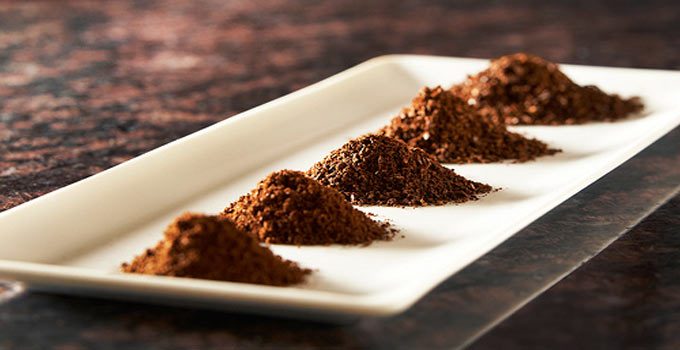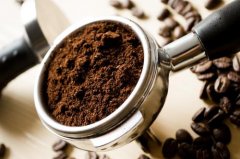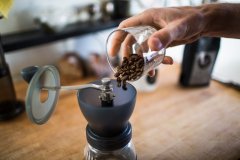[coffee powder thickness standard grinding] how to adjust the coffee powder thickness of different cooking utensils

Professional coffee knowledge exchange more coffee bean information please follow the coffee workshop (Wechat official account cafe_style)
How to judge and set the grinding degree of espresso
◎ degree of grinding (grinding coefficient)
The thickness of coffee powder is called 'grinding degree' or 'grinding coefficient'.
Usually, many people think that coffee powder is coffee powder.
But I didn't notice that even the coffee powder
If you use different brewing coffee utensils
Coffee powder also needs to be matched with different thicknesses.
If the coffee powder does not make a proper match of thickness and thickness
Will lead to uneven extraction.
The loss rate of fine powder is faster than that of coarse powder because of the loss of water.
On the other hand, the time of extraction will be different.
Finer powders will be over-extracted because they are soaked in water for too long.
The coarser powder will result in insufficient extraction due to insufficient soaking time in water.
So the degree of grinding (grinding coefficient) has a more subtle effect on the quality of coffee.
Can not be ignored!
The range of grinding degree (grinding coefficient) can be roughly divided into several types:
● espresso grinding Espresso Grind
More suitable for using espresso machine
The fineness of the degree of grinding (grinding coefficient) is quite sensitive.
● Turkish grinding Turkish Grind
More suitable for Ibrik pot
This kind of appliance is quite rare in Taiwan.
However, this kind of coffee utensils are often found in some European countries.
● rough grinding Coarse Grind
More suitable for filter kettle
Grinding Medium Grind in ●
More suitable for trickling filter pot or air stopper (siphon pot)
● fine grinding Fine Grind
More suitable for curling kettle or mocha kettle
Maybe ordinary people still don't know how to make a distinction between thickness and thickness.
If you have a grinder at home (more suitable for a grinder with 10 scales)
The number on the dial can be used as a reference for the degree of grinding (grinding coefficient):
(1) scale 1 Murray 1. 5 → is suitable for using espresso machine Espresso
(2) scale 2, Murray 2. 5 → is suitable for using ice drip teapot & mocha kettle
(3) scale 3MMI 3. 5 → is suitable for trickling filter pot (cooler pot) & plug air pot (siphon pot) & American coffee pot & Belgian Vienna pot
(4) scale 3. 5Murray 4 → is suitable for French filter kettle.
Through the above scale, it should be at the time of grinding.
The degree of grinding (grinding coefficient) can be used more accurately to match the coffee utensils used.
So when you hear that the more detailed you are, the stronger you are.
Then it can be said that this statement is wrong.
That's what I often hear.
However, after getting to the bottom of these error messages,
Salespeople who mostly come from commercial coffee.
Or a so-called counselor in a commercial coffee shop chain
Or the wrong message about coffee with a little knowledge.
The degree of grinding (grinding coefficient) is absolutely necessary to match the coffee utensils used to brew!
For example:
When it comes to brewing coffee in an American coffee maker
The degree of grinding with a strong taste (grinding coefficient) should be adjusted to scale 3 at most.
If the adjustment is lower than the scale 3, then the extraction will be uneven.
.
Important Notice :
前街咖啡 FrontStreet Coffee has moved to new addredd:
FrontStreet Coffee Address: 315,Donghua East Road,GuangZhou
Tel:020 38364473
- Prev

How do you drink coarse coffee powder? The importance of choosing the right grinding machine (bean grinder)
Professional coffee knowledge exchange more coffee bean information please pay attention to the coffee workshop (Wechat official account cafe_style) coffee bean grinding fineness how to judge, set the espresso grind degree ◎, you must first sharpen its tools. Grinding is also a key link that needs to be paid attention to. However, how to understand the advantages of all kinds of grinders (bean grinders)
- Next

[difference in coffee grinding thickness] what is the change in the taste of coffee with different coffee powder thickness?
Professional coffee knowledge exchange more coffee bean information please pay attention to coffee workshop (Wechat official account cafe_style) how to judge and set the grinding degree of espresso after roasting, the cells are destroyed and arranged loosely, but the cell wall is full of carbon dioxide, oil and aromatic flavors produced by pyrolysis, and the bean itself expands.
Related
- Beginners will see the "Coffee pull flower" guide!
- What is the difference between ice blog purified milk and ordinary milk coffee?
- Why is the Philippines the largest producer of crops in Liberia?
- For coffee extraction, should the fine powder be retained?
- How does extracted espresso fill pressed powder? How much strength does it take to press the powder?
- How to make jasmine cold extract coffee? Is the jasmine + latte good?
- Will this little toy really make the coffee taste better? How does Lily Drip affect coffee extraction?
- Will the action of slapping the filter cup also affect coffee extraction?
- What's the difference between powder-to-water ratio and powder-to-liquid ratio?
- What is the Ethiopian local species? What does it have to do with Heirloom native species?

